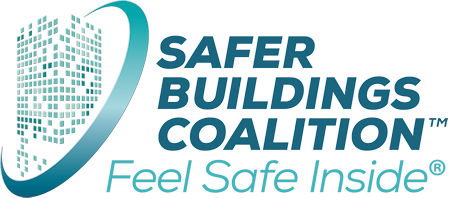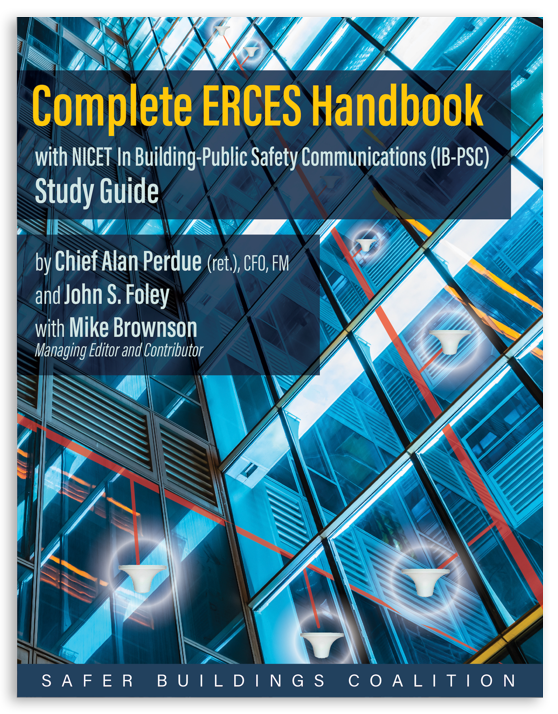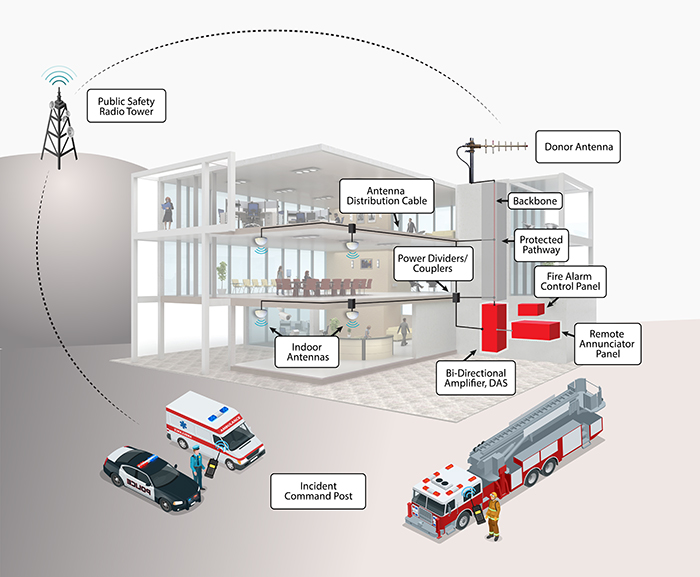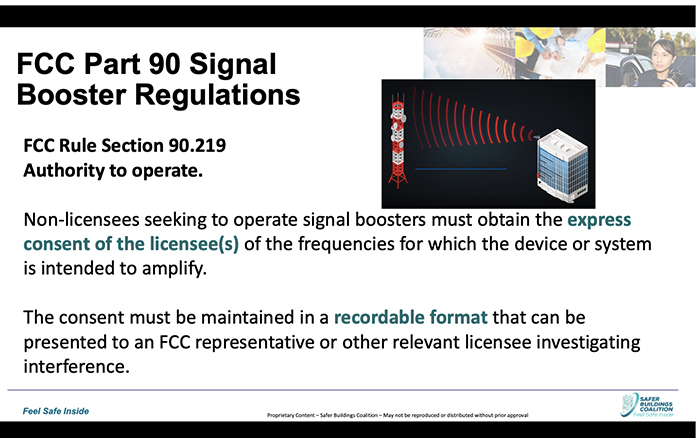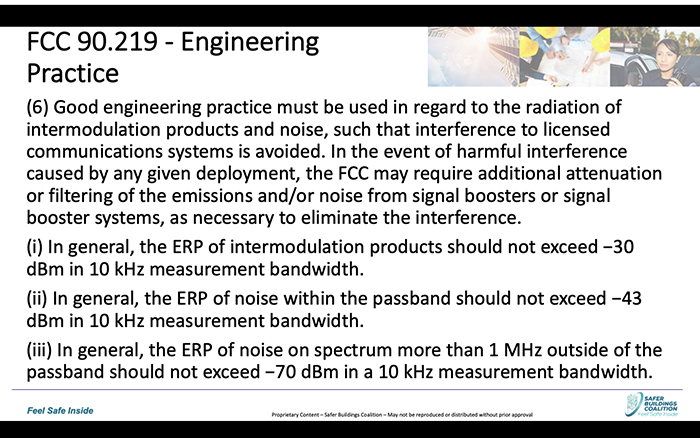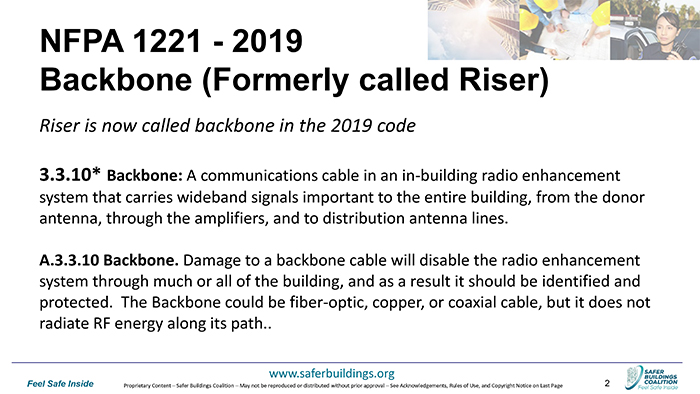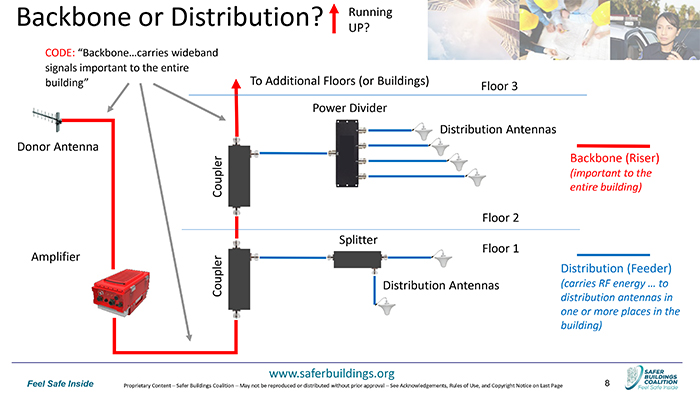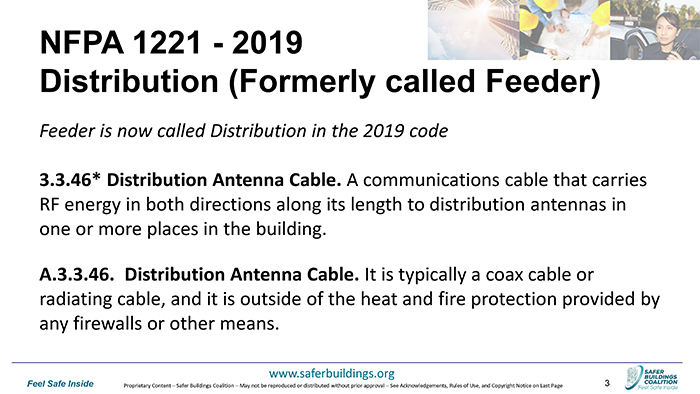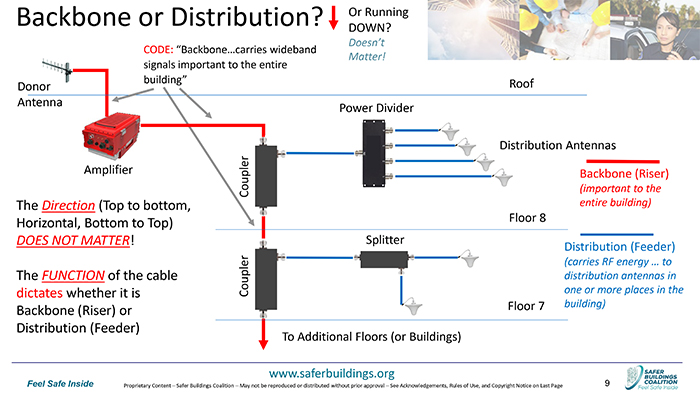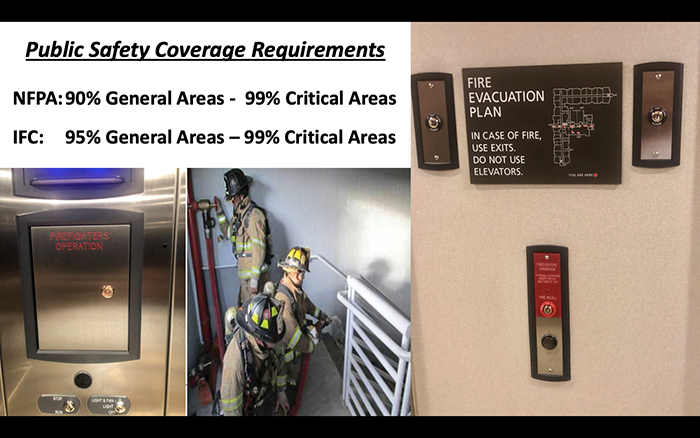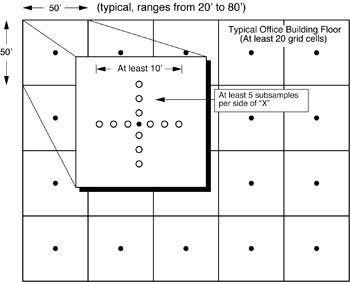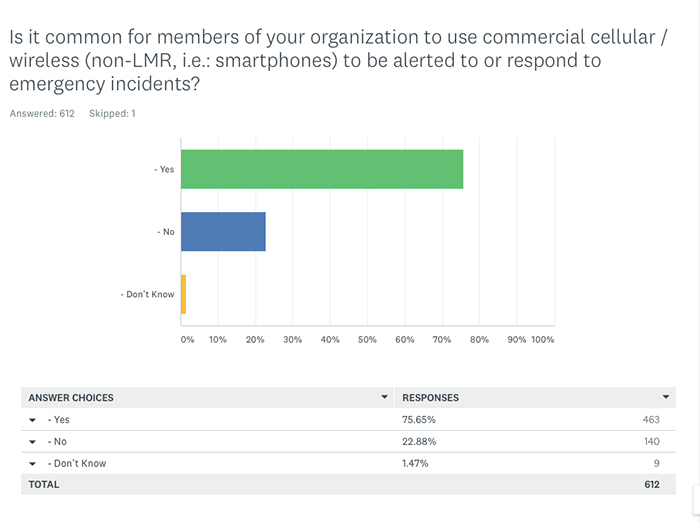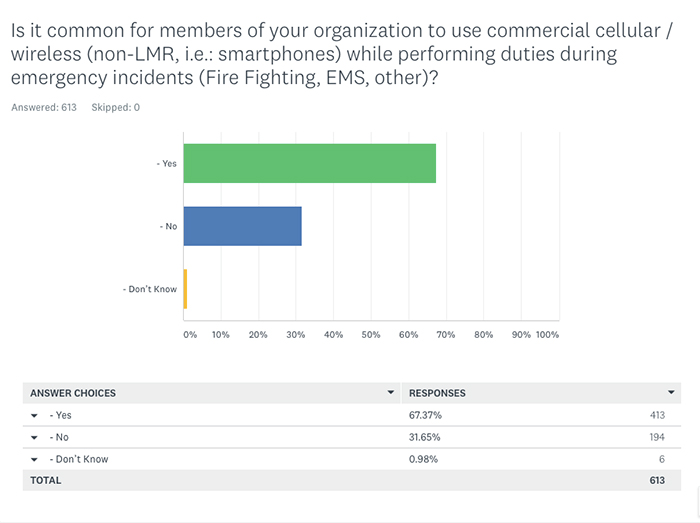For the most comprehensive discussion of ERCES, we recommend getting our Handbook:In-Building Public Safety PrimerWhat Is an In-Building Emergency Responder Communications Enhancement System? What Is an In-Building Emergency Responder Communications Enhancement System? An In-Building Emergency Responder Communications Enhancement System (ERCES) is a wireless communications system used by first responder and emergency services personnel, such as police, fire, emergency medical, homeland security, and disaster response agencies. First responder communications capabilities are a critical component of every emergency response that takes place within a building. The now-popular hand-held radio (portable) was invented in 1937 by a Canadian named Donald Hings, and it was utilized during World War II by both the Allies and the Axis. Following the war, the two-way radio market shifted to Public Safety agencies. One of the earliest providers of these public safety two-way radio systems was Motorola. As technology has improved, so too has the use of two-way radios. In fact, the National Institute for Occupational Safety and Health (NIOSH), which investigates line-of-duty deaths, recommends that all firefighters be provided with a portable radio and be trained on its proper use. This critical equipment is equally important to law enforcement and emergency medical responders. Additionally, many emergency responders utilize new types of communication technologies that must remain viable while performing their respective duties. This includes, but is not limited to, cellular voice communications, data, LTE, location information, etc. When emergency responders enter a building their ability to maintain interoperable and continuous communications is paramount to the protection of both public safety and the public’s safety. An In-Building ERCES ensures that communication signals can penetrate into all areas of buildings in accordance with model fire codes and standards. This includes areas that are especially difficult for Radio Frequency (RF) to penetrate, such as exit stairwells, occupant use elevators, basements, buildings with Low-E glass, thick-walled or other areas shielded with various types of building materials.
What Is an In-Building Solution? For many years, public safety agencies utilized bands of frequencies, in the VHF and UHF parts of the spectrum. These frequencies are allocated by the Federal Communications Commission (FCC) for communication between fixed base stations and land mobile vehicle-mounted and portable transceivers. Police radio and other public safety services, such as fire departments and Emergency Medical Services (EMS), have traditionally been found in the VHF and UHF parts of the spectrum (45MHz, 150MHz, 220MHz, 400MHz, 500MHz). These analog radio systems were primarily designed for voice communications. First responders need a reliable, resilient, optimized wireless broadband network to carry out their mission. Not only must they be able to communicate instantly without interruption, but agencies must collect and filter through all the information streaming in from the community. Interoperability among agencies and secure transmissions are critical to an effective coordinated response. An optimized Public Safety network is needed to assure priority communications the moment they’re needed. An optimized network may also provide end-to-end encryption, safeguarding sensitive information transmitted over the air wirelessly. Much like a Cellular Distributed Antenna System (DAS), an In-Building ERCES enables sending and receiving to the area’s various public safety radio bands, often using bi-directional repeaters, voting receivers, etc. and a series of antennas distributed strategically throughout a building to pass the transmit and receive RF from the radio system to individual radios. In-building solutions may be either passive or active. In-Building ERCES are needed for the same reason that In-Building Cellular DAS are being installed: To provide signal levels that allow people to communicate effectively. Radio signals have limited propagation capability through various types of building materials. Factors that limit the ability to pass communications signals may include: 1) how deep inside a building the receiver may be, 2) wall composition, 3) whether a building has Low-E Glass or other energy-saving cladding and 4) the specific frequencies in use (low frequencies penetrate better). Today’s emergency responders not only rely on dependable voice communication, but increasingly also on data, telemetry, and location accuracy information. In an emergency situation where a matter of seconds can mean the difference between life and death, every tool at the emergency responder’s disposal must be available and absolutely reliable. The answer to that question is really very simple: When signal coverage and quality are inadequate inside a building. The need for in-building wireless communications for Emergency Responders resulted in the development of national model codes by the National Fire Protection Association (NFPA) and the International Code Council (ICC) as early as 2009. NFPA 1, NFPA 72, NFPA 1221, National Electrical Code, International Fire Code, and the International Building Code are some of the codes that contain provisions related to ERCES issued by these code-making bodies. Many states, cities and counties in the United States adopt one or more of these published codes/standards. The NFPA and ICC continue to modify national level model codes focused on In-Building ERCES. National level model codes/standards will also lead to the standardization of equipment, installation requirements and qualifications for in-building system engineers and installers. The NFPA and ICC national level model in-building code development is being driven primarily by fire service jurisdictions. However, the requirements for emergency responder communications coverage are designed to include all public safety agencies, including law enforcement and emergency medical services. The NFPA and ICC initiatives are separate but complementary. While the precise provisions of the model codes may vary slightly between the two code development groups, key specifications involve significant commonality across the two initiatives. In addition, local jurisdictions may include code modifications (additions and/or deletions) from the national level model code framework. In other words: Each jurisdiction may “customize” the national level model codes to meet any unique local requirements. A number of jurisdictions have enacted, or are considering enactment of, local requirements which require a requisite level of public safety communications reliability in building as a condition for occupancy. The specifics of these ordinances and codes may vary from jurisdiction to jurisdiction, but most include, but are not limited to:
and
As an example, as of December 31, 2014, the New York City Building Code requires, in Sections 403.4.4 and 907.2.13.2, that an in-building auxiliary radio communication system (ARCS) be installed and maintained in all newly‑constructed high-rise buildings. An ARCS is a wireless two-way building communication system for Fire Department use only that receives and transmits Fire Department portable radio frequencies within the building. An ARCS typically consists of a transceiver (base station) connected to a building-wide antenna system, with a radio console in the building lobby. Section 917.1.2 of the New York City Building Code and Section FC 511 of the New York City Fire Code together require that ARCS be installed, acceptance tested, operated and maintained in accordance with the Fire Code and the rules of the Fire Department. The Fire Department has adopted rules that establish requirements for the design, installation, operation and maintenance of ARCS, including the testing procedures necessary to confirm that the ARCS is providing adequate radio coverage in the building in all areas accessible for firefighting operations. The requirements seek to ensure that ARCS achieve their intended purpose and, once installed, are continuously maintained in good working order. The rules set forth standards, requirements and procedures for installation, acceptance testing, daily inspection, annual certification and five-year recertification of ARCS. It requires that the testing of ARCS be supervised by a person holding a Fire Department license, known as a Certificate of Fitness, who knows the New York City Building Code, Fire Code and Fire Department rule standards that apply to ARCS. The rule reflects the Fire Code requirement that this person hold a General Radiotelephone Operator License issued by the United States Federal Communications Commission (FCC). (Source – www.cityofnewyork.us) Who are the Stakeholders and Role Players? The installation of an ERCES in any building will involve several unique stakeholders. It is imperative that all stakeholders are involved in the process of designing, implementing and testing an ERCES. The stakeholders typically fall into four basic categories: building owner, system integrator, authority having jurisdiction (AHJ) and FCC frequency license holder. Building Owner: The building owner is responsible for compliance with the adopted codes and standards in the geographic location of the subject building where the ERCES is being installed. System Integrator: An enterprise that specializes in designing, coordinating, implementing, and testing an ERCES. The system integrator may perform all aspects of a project or utilize other sub-contractors to perform the work. FCC Frequency License Holder: An organization, office or individual responsible for operating a Private Land Mobile Radio Services (PLMRS) that must meet the requirements as set forth in FCC 90.219. The Licensee must provide written authorization for a signal to be rebroadcast. The licensee is responsible for the proper operation and are responsible for correcting any harmful interference that signal booster operation may cause. Like most fire and life safety system mandated within the fire and building codes, In-Building ERCES are typically the responsibility of the building owner or equivalent. At times, Cellular DAS installations have been financed in whole or in part by Wireless Carriers or Third-Party It is also important to point out that building occupants believe certain utilities should be at the core of what is provided within buildings they purchase, lease or rent. Water, electric power, gas have been in that category for many years. However, today, with the proliferation of wireless devices and their significant use on a daily basis by building occupants, communications via a wireless signal is expected, too. One note of importance is that greater than 70-80% of calls to 9-1-1 communications centers come from a mobile device. The public expects their devices to work when they have an emergency. Additionally, the public expects the emergency responders to be able to perform their duties when responding to these emergencies, and that requires the ability to communicate. Building owners must consider the perception of doing nothing to insure in-building communications capabilities for both emergency responders and the public and the potential liability associated with it. That said, with the proliferation of code adoptions at the state or local level, ERCES are becoming analogous to mandatory fire sprinkler and fire alarm systems – just part of the life safety ecosystem – and a part of doing business. Deployment of solutions for reliable public safety in-building communications coverage must consider the spectrum environment, building parameters, and the users’ operational needs. As with most systems for use by public safety, whether indoor or outdoor, reliable solutions require customization, high-quality products, good systems engineering, proper installation and, most importantly, annual inspection, testing and maintenance. Reliable In-Building ERCES are not one-size-fits-all “cookie cutter” designs. Each solution must be properly designed for the respective building(s) whose communications problems it is intended to solve. Prior to beginning any work related to In-Building ERCES, it is vital that all stakeholders become familiar with the rules of the trade. Listed below are some of the important documents and key points that one must be familiar with in order to perform any type of ERCES services. Federal Communications Commission (FCC) Part 90.219: 90.219 contains technical and operational rules that allow the use of signal booster systems for land mobile radio (LMR). It is imperative that anyone involved in the design and installation of an ERCES system have a clear understanding of the requirements within 90.219. A few key areas to note:
Codes and Standards: VERSION ALERT: THIS IS AN OLDER VERSION BASED ON NFPA 1221 - NFPA 1225 - 2022 CONTAINS MANY IMPROVEMENTS, AND THIS PAGE RQUIRES AN UPDATE The requirements for the installation of ERCES are located in both the International Code Council’s International Fire Code and the National Fire Protection Associations Standard NFPA 1 and NFPA 1221. Many jurisdictions adopt these model codes on a local or state level and often add or delete specific requirements. For that reason, the published editions of their code adoption may vary. The Safer Buildings Coalition has developed a code reference card that contains three editions of the model codes for both organizations. We identify a specific category related to ERCES and then note the corresponding code section. The code reference card can be found here: https://sbc.memberclicks.net/quick-code-reference You may access the NFPA and IFC codes here: IFC: https://codes.iccsafe.org/content/IFC2018P4 Some of the key areas one needs to be familiar with include, but are not limited to, the following:
Now that we’ve examined the major components of the code/standards, let’s take a look at the responsibilities of the building owner, frequency license holder and the AHJ in regards to radio enhancement systems. Responsibilities of the Frequency License Holder: The frequency license holder holds the key to being able to rebroadcast on the frequencies utilized by the emergency responders as provided for in FCC Part 90.219. It is imperative that every ERCES being proposed includes communications with, and written authorization from, the frequency license holder. The frequency license holder will evaluate the proposed solution and determine what, if any, negative impact it may have on their macro system. Their primary focus is keeping the public safety radio system up and running with limited-to-no interference. Responsibilities of the AHJ: The AHJ has many responsibilities, which may include the plan review, permitting, site inspection and system acceptance of the ERCES. Some AHJs may have limited experience with an ERCES installation and look to a third-party inspection service to perform ERCES duties. First and foremost, the AHJ must decide which buildings fall under the jurisdiction of their adopted code(s). New buildings only? All buildings of more than 5000 square feet? Existing buildings that have undergone recent modifications? The AHJ also must specify the frequencies to be amplified on the system, being mindful of all emergency response agencies and any new frequencies planned by the public-safety agency in the future. Because all amplification systems introduce time delays, the AHJ must specify the maximum delay (in microseconds) that can be tolerated by the radio system. Usually, only narrowband channelized amplifiers introduce enough delay to cause problems in overlap coverage areas. Finally, the AHJ must ensure that the integrator meets the required certifications and qualifications to install the system. Currently, the Safer Buildings Coalition is working with the National Institute for Certification in Engineering Technologies (NICET) to develop a nationally recognized certification for the In-Building ERCES workforce. Physical Construction and Design Considerations Donor Antenna(s) and Placement Close coordination with the building owner is key for this consideration. The antenna location should be chosen to minimize coax cable run distances while having good line of sight to the licensee-approved transmitting station. Ideally, it should be near a building edge to avoid transmitting signal across a rooftop. Signals transmitted across rooftops can leak into floors below, causing an RF feedback loop, which can degrade or disrupt system performance. Suitable roof penetration and waterproofing techniques are required. Existing penetrations are ideal. It is best to coordinate with the owner’s roofing contractor if a new penetration is required, especially in the case of rubberized roofing. Not doing so could void the owner’s roof warranty. Another consideration is antenna height. At issue are visual aesthetics, PIM (Passive Intermodulation Interference) performance, and wind loading. In general, property owners prefer that donor antennas are not obvious. RF neutral screens and other camouflage techniques can be used to minimize this concern. PIM interference can be caused by locating an antenna too close to metal structures of metallic roof flashing along building edges. Extra antenna height and careful placement can reduce or eliminate this problem. Finally, antenna masts and ballast suitable for the required height are important. Taller masts must be sturdier and use more ballast to handle added wind loading. These must be matched to roof load bearing ability and antenna type. Additionally, many AHJs require that the donor antennal be permanently affixed (versus an antenna sled). This requirement will be in the 2021 model code. Cables must be properly protected to avoid cable or roof damage. Best practice is to route donor coax through PVC, raised on sleepers to avoid roof damage. Proper grounding and lightning arrestors are required per code. Cable Runs After the outside surveying is complete, the next order of business is identifying a vertical chase that will get the cable runs from floor to floor. Once this has been identified, a network closet/IT room where the booster equipment can be parked must be located. Ideally, you would want the two elements – the vertical chase and the network closet/IT room – to be as close to each other as possible – if not one and the same. Make sure you identify the pathway survivability requirements from the AHJ. A walk through the facility should allow the DAS designer to begin to see potential cable runs in certain locations more so than others. Certain areas should jump out that would be better locations for internal antennas. These areas should be hallway juncture points and areas that are in need of strong coverage (e.g., manager’s office, security office, etc.) consistently. This would mandate a dedicated internal antenna within close proximity. Another item to look for is the method of transport for the cabling. Are there dedicated cable trays? Is conduit required? Does the local fire code mandate plenum ratings on the cable? If fiber is the method of delivering RF, is there any dark fiber available to use? If so, what type is it? Is the fiber of the single mode or multimode variety? What do the ceilings look like? False ceilings? Hard lid ceilings? A mix? The amount of labor to get through different ceiling types will vary, as will the time/cost. Ceiling types will have a huge impact on which antenna to use. In some cases, the end customer may want the antennas out of view. Examples of what the antenna looks like should be presented to the customer for approval. How high are the ceilings? Will a hydraulic lift be required to gain access for antenna installation? These are items that need to be considered when doing the site walk. An area where core drilling is required is an important cost/time consideration that can be identified during a thorough site survey. Firewall locations need to be identified as they require special prep work for penetrations and pulling cable from one side to the other. Wall Construction and Attenuation Factors The building materials used in the construction of the building and walls should be scrutinized closely. What is the makeup of the walls? Drywall? Sheetrock? Cement blocks? Brick? Is there any metal? In hospital environments, lead will be present in the walls near radiology units. What about insulation or ductwork? Metallic backing on certain types of insulation will strongly attenuate RF signals from propagating. Metal duct work will also have an impact on a RF signal. NFPA 1221 specifies Testing and Maintenance requirements.
The AHJ is allowed some discretion when it comes to testing, but the standard recommends voice-quality testing (using actual radios on the hip) on a grid system. A grid is overlaid onto a floor area to provide 20 grid cells. It is recommended that each critical area be its own grid. For most buildings, using a minimum grid dimension of 20 feet and a maximum grid dimension of 80 feet will suffice to encompass the entire floor area. Where a floor exceeds 128,000 square feet, it is recommended that the floor be subdivided into sectors having an area less than or equal to 128,000 square feet and each sector be tested individually with 20 grids. Measurements are to be collected while walking in an “X” pattern, with at least five measurements per side of the X and at least one measurement every five feet. The collected samples then are linearly averaged and applied to the center of the grid cell. The gridding and signal-measurement methodology is shown in Figure 1 (below). Grid Test
FIGURE 1 Signal-strength measurements are to be collected while walking in an “X” pattern, with at least five measurements per side of the X and at least one measurement every five feet. Public Safety Broadband – FirstNet (Source: www.firstnet.gov) Signed into law on February 22, 2012, the Middle Class Tax Relief and Job Creation Act (MCTRJCA) created the First Responder Network Authority (FirstNet). The law gives FirstNet the mission to build, operate and maintain the first high-speed, nationwide wireless broadband network dedicated to public safety. FirstNet will provide a single interoperable platform for emergency and daily public safety communications. This broadband network will fulfill a fundamental need of the public safety community as well as the last remaining recommendation of the 9/11 Commission. FirstNet will bring 21st century tools to tens of thousands of organizations and individuals that respond to emergencies at the local, state, tribal and federal levels. The FirstNet organization is the first of its kind. Never before has Congress established an independent government authority with a mandate to provide specialized communication services for public safety. Using nationwide 700 MHz spectrum, FirstNet will put an end to decades-long interoperability and communications challenges and help keep our communities and emergency responders safer. The law gives FirstNet a blueprint for its mission. It outlines processes and guidelines that FirstNet must follow in building the network. FirstNet is tasked with cost-effectively creating a nationwide network and providing wireless services to public safety agencies across the country. Through the assessment of fees, FirstNet must generate sufficient funds to enable the organization to operate, maintain and improve the network each year. Congress made history by allocating valuable spectrum and up to $7 billion in funding for the construction of the FirstNet network. To create a nationwide network, all 56 U.S. states and territories must have a radio access network that is connected to the FirstNet core network. To contain costs, FirstNet is tasked with leveraging existing telecommunications infrastructure and assets. This includes exploring public/private partnerships that can help support and accelerate the creation of this new advanced wireless network. FirstNet is an independent authority within the U.S. Department of Commerce’s National Telecommunications and Information Administration. FirstNet is governed by a 15-member Board consisting of the Attorney General of the United States, the Secretary of Homeland Security, the Director of the Office of Management and Budget, and 12 members appointed by the Secretary of Commerce. The FirstNet Board is composed of representatives from public safety; local, state and federal government; and the wireless industry. These dedicated individuals bring their expertise, experience and commitment to serving public safety and meeting the FirstNet mission. The Future of Public Safety Communications: New Technologies For decades, Public Safety Agencies relied on Land Mobile Radio (LMR) for wireless mission-critical communications. But that is quickly evolving. In late 2017, the Safer Buildings Coalition surveyed the International Association of Fire Chiefs (IAFC) to get a sense of how cellular communications have been incorporated into emergency response. Here are the findings:
75% of respondents reported using commercial cellular service to be alerted to or respond to emergency incidents, and 67% reported using commercial cellular service while performing duties during emergency incidents. There are many drivers to these changes, including, but not limited to:
It’s important to remember that not every emergency response features fire fighters dragging hoses into a burning building. In fact, most don’t. Indeed, of all calls to 9-1-1 requiring a dispatch, about 70% are for law enforcement, 20% are for EMS, and the balance are for fire emergencies. Impacts: Regulatory, Technology, Market, Building Owner Business Case Regulatory Fire Code today contains the following language: NFPA 1221-2019: 9.6.10 Frequencies. The public safety radio enhancement system shall be capable of transmitting all radio frequencies, as required by the AHJ assigned to the jurisdiction, and be capable of using any modulation technology in current use by the public safety agencies in the jurisdiction. As such, fire code is technology agnostic. It does not specify Land Mobile Radio, specific frequency bands, or who the license holder may be. These are to be specified by the Authority Having Jurisdiction (AHJ) in the jurisdiction where the code is being enforced. Unlike earlier version of code that specified Fire Department frequencies, current code simply states public safety agencies in the jurisdiction. FCC rules, contained in 47 CFR § 90.219 - Use of signal boosters, focuses on Land Mobile Radio services and frequencies. These rules require Express Consent from the License Holder for anyone to legally rebroadcast their licensed frequencies. However Cellular Communications are governed by 47 CFR § 20 Commercial Mobile Services. Consider the following scenarios: A jurisdiction’s AHJ enforces fire code on a building owner to solve for a lack of public safety agency radio coverage inside their building. They specify the local 700 band LMR radio frequency in the jurisdiction. This frequency is licensed to a local entity, and you would presume (or hope) that the AHJ and the License Holder are coordinated in their efforts to permit rebroadcast, and the License holder would issue written consent. But what if the AHJ adds a Commercial Mobile Service to the required frequency list? Will the wireless carrier consent to having their service rebroadcast in the building? What standards should the system be designed to? Should it be fully code compliant? (redundant power, coverage areas, rated enclosures, etc.?). Technology, Market, Building Owner Business Case Who will pay? While LMR services are exclusively for the use of public safety agencies, Commercial Mobile Services are shared with the public. Should building owners pay to augment commercial carrier networks? What about future technologies like CBRS, 5G (6G?), and more? Fire code is already technology agnostic. Regulations, standards, processes, and business models need to be adapted to keep pace. Handset technology continues to evolve. Many manufacturers are now rolling out multi-technology handsets that provide LMR, Wi-Fi, and Cellular capabilities in a hardened form factor. In-building repeater technology will also continue to evolve to provide better flexibility and cost performance. Conclusion
|
